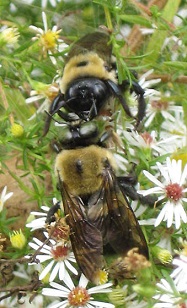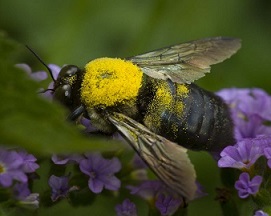Interactions
Nestmate to non-nestmate interactions and male to female
interactions have been observed when looking at Xylocopa
virginica.
While looking at nestmates and
non-nestmates a difference is observed between the way males
and females are treated when entering an unfamiliar area. When
male non-nestmates enter an area, the surrounding male members
of the nest will attack this individual. As noted on the
Form
and Function page, the two types of males that defend the nest
include satellite males and resident males. Each type of male
has a distinct role including the resident males guarding above
the nest and the satellite males guarding around the sides of
the nest (Prager and Richardson 2012). It is advantageous for
the males to recognize other male nestmates quickly so they can
put their energy towards attacking unwanted visitors, an idea
known as the dear enemy effect (Barrows 1983, Peso and Richards 2010).
To gain access and
attention from females, males defend the territories close to
the nest
(Barthell et al. 2006). Males will act with aggression
in different ways with the most prominant being pushing and
biting. Pushing is a behavior in which one bee applies contact to the head and does not
release pressure until the other bee is moved far
enough away from the nest. The next example of aggressive
behavior is biting. Both pushing and biting
are traits that occur sooner and more often in non-nestmate male
interactions. Aggressive behaviors are mainly seen
in males as their job is to defend the nest (Peso and Richards
2010).
are treated when entering an unfamiliar area. When
male non-nestmates enter an area, the surrounding male members
of the nest will attack this individual. As noted on the
Form
and Function page, the two types of males that defend the nest
include satellite males and resident males. Each type of male
has a distinct role including the resident males guarding above
the nest and the satellite males guarding around the sides of
the nest (Prager and Richardson 2012). It is advantageous for
the males to recognize other male nestmates quickly so they can
put their energy towards attacking unwanted visitors, an idea
known as the dear enemy effect (Barrows 1983, Peso and Richards 2010).
To gain access and
attention from females, males defend the territories close to
the nest
(Barthell et al. 2006). Males will act with aggression
in different ways with the most prominant being pushing and
biting. Pushing is a behavior in which one bee applies contact to the head and does not
release pressure until the other bee is moved far
enough away from the nest. The next example of aggressive
behavior is biting. Both pushing and biting
are traits that occur sooner and more often in non-nestmate male
interactions. Aggressive behaviors are mainly seen
in males as their job is to defend the nest (Peso and Richards
2010).
As stated above, X.
virginica is very territorial and have been known to attack
anything that may come in close
contact with the nest they are protecting. They will lunge at
insects of other species that have no interest in competing for
the females and even Dandelion Pappi as possible threats to the
nest (Barrows 1983). Click
here to learn more about Dandelion Pappi or Taraxacum
officinale and see why it is hard to believe that X.
virginica views this plant as competition.
The only instance in which aggression
was not displayed between non-nestmates and nestmates was when a
non-nestmate female entered an area with males. Males show a decrease in
aggression and increase in tolerance when a
female approaches, which is very different when males approach
an unfamiliar nest. This decrease in aggression is due to the
fact that males see non-nestmate female as a potential
mating partner (Peso and Richards 2010). Males produce
pheromones while hovering and defending the nest that help
attract these potential mates (Barthell et al. 2006). They want to attract new females to avoid deadly inbreeding as many
inhabitants of the nest are related to one another. This may
lead to competition in the nest between the females as the
dominant female only likes to have a small number of workers in
the nest that consume the resources and make no positive
contributions to the nest (Peso and Richards 2010).

The idea that the Eastern Carpenter
Bee has been labeled as a nectar robber is not an accurate
description of
the job they do.
The term "nectar thieves" puts X. virginica in a negative light, when in
actuality it benefits not only the plant they rob from, in this
case being the Rabbiteye Blueberry Plant, Vaccinium ashei,
but also Honey Bees, Apis mellifera (Sampson et al.
2004).
X. virginica have been
known to sometimes take nectar properly through the
petals, but have been seen more commonly “stealing the nectar”.
They form slits in the base of the petals
with their mouths to obtain the nectar (Adler and Irwin 2006). The Eastern Carpenter
Bee
steals nectar around March to early April. This interaction
benefits the A. mellifera as these organisms have very
short tongues, and therefore cannot reach the nectar glands
without the help of the Eastern Carpenter Bee first robbing the
plant (Peso and Richards 2010). It was noted that 4%-50% of
flowers robbed by the Eastern Carpenter Bees drew 65%-100% of Honey Bees
to that plant (Sampson et al. 2004). This unique adaptation of
robbing nectar was only observed in the X. virginica
(Adler and Irwin 2006). To see the Honey Bee, A.
mellifera for yourself, click the link
here.
Bees
to that plant (Sampson et al. 2004). This unique adaptation of
robbing nectar was only observed in the X. virginica
(Adler and Irwin 2006). To see the Honey Bee, A.
mellifera for yourself, click the link
here.
This interaction not only helps
species with shorter tongues like the A. mellifera
gather nectar, but it is also
very beneficial to the plant. After the nectar is
robbed, the Rabbiteye Blueberry Plant, V. ashei, has an
increase in the amount of pollen grains on the plant by about
forty grains of pollen. This increase in pollen is about twenty
times higher than if the plants had not been robbed by X.
virginica.
Increasing the amount of pollen
heightens their chances of being collected by pollinators to
help with cross fertilization. Cross pollination levels help
with pollination, fruit set, and seed production. Overall, we can see that the
interaction between X. virginica, A.
mellifera, and V. ashei act as
mutualistic
relationships with each group benefitting in different ways
(Sampson et al. 2004).

Plants have many forms of
reproduction aside from nectar that must be taken into account
including the use of pollen
grains. Larger bodied X. virginica are able to carry
the greatest amount of pollen on their bodies after a floral
visit compared to Bombus bimaculatus, Apis
mellifera, Osmia lignaria, and Habropoda
laboriosa. While X. virginica can carry the most
pollen, this is not advantageous to the plant as they have the
lowest pollen transfer despite their large size. This could
result in a lower fitness for the plants that
X. virginica are attracted to as this pollen is not
being spread to other plants (Adler and Irwin 2006).
Continue to
Facts
Return to
Home
Go to
References